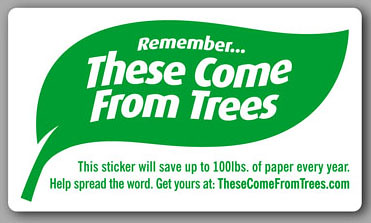I just love this visualization of the These Come From Trees purchase history overlaid by Zip Code on a map of the US.
Special thanks to my friend Jonah Berger, author of the awesome book "Contagious: Why Things Catch On", who thought that the viral nature of These Come From Trees stickers would be an interesting thing to check the virality of.
In the case of this animation, it's purchases since 2009, overlaid on their Zip Code, and weighted by purchase size.
So you can see when large purchase shows up (often times for a University, like the University of Washington, in Seattle), and then how that is preceded by certain purchasing behavior, and then succeeded by what appears to be accelerated purchasing behavior.
Like check out how Wisconsin goes crazy after the initial large purchase in early 2011, having previously been more sporadic.
Neat stuff!
These Come From Trees Sticker

This is the sticker we're hoping can save a couple hundred thousand trees a year. Amazing how the right message at the right time can make the difference.
Quick Facts about "These Come From Trees"
- Check out our "welcome post" to learn about what inspired this project.
- Eco-minded Citizens: See what you can do with These Come From Trees!
- K-12 Schools, check out our Education Challenge
- Hundreds of Businesses Using These Come From Trees Stickers
- Proven up to 29% paper use reduction
- Follow us on Twitter: https://twitter.com/TCFromTrees
- --------------------------------------------------------------------
- A single "These Come From Trees" sticker can save around a tree's worth of paper, every year
- More than 50,000 stickers distributed since 3/07
- Laminated stickers hold up to washing.
- A typical fast food restaurant with two bathrooms can use up to 2000 pounds of paper towels a year
- The average coffee shop uses 1000 pounds of paper towels a year
- A single tree produces around 100 pounds of paper
- Roughly 50,000 fast food restaurants in the US
- 200,000 gas stations in the US
- 14,000 McDonalds' in the US
- 10,000 Starbucks in the US
Monday, June 10, 2013
Subscribe to:
Comments (Atom)
